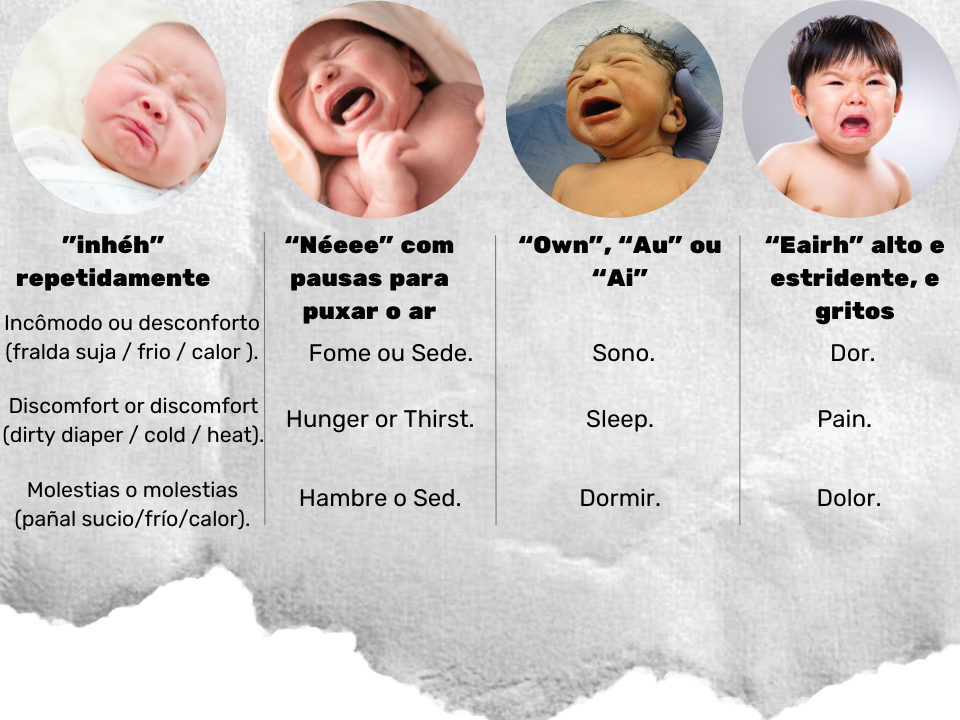Os bebês são seres humanos que ainda não possuem a capacidade de se comunicar verbalmente, por isso, o choro é a principal forma de expressão de suas necessidades e sentimentos. Os bebês choram porque é uma forma de comunicação.
Eles podem estar com fome, cansados, incomodados, com dor ou com outras necessidades que precisam ser atendidas. Chorar é a maneira deles pedir ajuda para seus cuidadores.
O choro pode indicar uma variedade de coisas, incluindo fome, sono, dor, desconforto, ou simplesmente a necessidade de atenção e carinho.
FOME
Fome é uma das principais razões para o choro de um bebê. Se o bebê acabou de acordar de uma soneca ou se já passou algum tempo desde a última mamada, é provável que ele esteja com fome e comece a chorar. A fome também pode ser indicada por sons de sucção ou movimentos da língua.
SONO
Sono é outra razão comum para o choro de um bebê. Se o bebê está cansado e precisa dormir, ele pode começar a chorar. Alguns sinais de sono incluem puxar as orelhas, coçar os olhos, ou ficar agitado e irritado.
DOR
Dor e desconforto também podem causar choro em um bebê. Por exemplo, se o bebê estiver com cólicas, ele pode chorar intensamente. Além disso, problemas como refluxo, gases, ou uma fralda suja também podem causar desconforto e choro.
ATENÇÃO
Por último, o choro pode indicar a necessidade de atenção e carinho. Bebês precisam de contato físico e interação para se desenvolverem emocionalmente saudáveis. Se o bebê estiver chorando sem nenhuma outra razão aparente, ele pode simplesmente estar precisando de um colo ou de brincar com alguém.
É importante lembrar que todos os bebês choram, e isso é normal. No entanto, se o choro for frequente e intenso, é importante consultar um pediatra para descartar qualquer problema de saúde. Além disso, é importante aprender a identificar os sinais de necessidade do bebê para poder atender suas necessidades de forma rápida e eficaz.

Segue a relação do tom e sonoridade do choro do bebê que pode indicar alguma situação de comportamento, avaliado pelos pediatras:
- “inhéh” repetidamente / repeatedly /
- “Néeee” com pausas para puxar o ar / with pauses to take a breath / con pausas para tomar un respiro
- “Own”, “Au” ou “Ai”
- “Eairh” alto e estridente, e gritos / loud and shrill, and screams / fuerte y estridente, y gritos
- Importância de levar o bebê no pediatra.
[su_table responsive=”yes”]
| Aplicativo que traduz os latidos do seu cachorro ->> |
| Novo câmbio, é hora de conhecer a Argentina ->> |
| Fique em forma, usando a tecnologia a seu favor ->> |
| Aprenda a gastar menos ->> |
[/su_table]
Levar o bebê ao pediatra é importante para garantir que ele esteja saudável e para detectar e tratar qualquer problema de saúde precocemente. O pediatra pode realizar exames físicos regulares, vacinar o bebê contra doenças e fornecer orientações sobre alimentação, sono e outros aspectos importantes do cuidado infantil.
Além disso, o pediatra pode identificar e tratar problemas de saúde mais complexos, como problemas de desenvolvimento, doenças crônicas e infecções. É importante levar o bebê ao pediatra regularmente, geralmente a cada 3-4 meses no primeiro ano de vida.